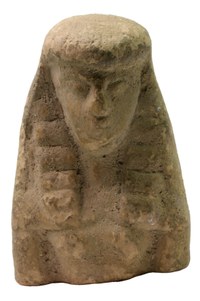Female relief figurine
|
Female relief figurine, Inv. T I-53 Provenance: Unknown. State of preservation: Upper part of the body with upper arms, straight at the bottom. Injuries to chin, nose, hair, arms and breasts. Solid. Front from the mould, back smooth, slightly convex. Fine yellow-brown clay (10YR 7/3-7/5). Brownish painting, spilling over to the reverse at the head. Dimensions: H: 7,1 cm; W: 4,9 cm; D: 2,1-2,6 cm. References: Not published. |
Description: The head and torso of the female figurine are approximately oval. The head ends in a very flat curve at the top and the torso ends horizontally at the bottom, with a slight rise to the left. Especially on the right side the edge is a little curved up. The arms lie close to the body. Two long strands of hair, divided into broad horizontal stripes, frame the face and fall on the chest. Between the ends of the strands, opposite tails of the robe appear plastically.
The face has the shape of a hanging triangle, with a rounded chin and a low forehead under a thick bulge of hair divided into fine vertical strands. Arched brows are sculpted above the large slightly bulging eyes. A broad nose dominates the face. The mouth is closed; the slightly upturned lips are not joined at the corners of the mouth. The profile view shows an increased micrognathia (receding chin) due to abrasion.
Commentary: The female relief figure wears a so-called stepped or tiered hairstyle, a characteristic of the Daedalian period (7th century BC). Similar terracotta statuettes have been recovered from Cretan sanctuaries [1]. The women are dressed in long, tightly girded robes and a symmetrical shoulder cloak, the epiblema, which - as on the example in Giessen - is closed with two taps above the breasts. The outstretched arms lie close to the sides of the body [2].
A parallel in Würzburg [3] is so close to T I-53 in dimensions, posture and hairstyle that both must go back to the same mould. In contrast to the upper body fragments with clear fractures [4], the Giessen and Würzburg statuettes are smooth at their lower ends and, like the rest of the figure, painted with brownish colour. There are no traces of later treatment. The mould of the Giessen and Würzburg specimens was probably designed from the outset for the production of half figures.
Determination: 7th century BC, from Crete.
[1] M. Tsipopoulou, Eidolio in Daidalika syllogis mitsotaki, AAA 1981, 289-292 fig. 15-17; G. Rizza, Le terrecotte di AXÒS, Annuario della Scuola Archeologica di Atene 45-46, 1969, 211-300 figs. 12, 80 a; R. A. Higgins, Greek Terracottas (London 1967) 21 pl. 10 D; O. Pilz, Frühe matrizengeformte Terrakotten auf Kreta (Möhnesee 2011) 194 f. fig. 4 pls. 7. 1. 3.4 pls. 81. 7. pl. 9;. W. Güntner, Votivstatuette, in: Die Sammlung Kiseleff II. Martin-von-Wagner-Museum der Universität Würzburg (Mainz 1989) 19-20, no. 36, pl. 11; St. Böhm, Die nackte Göttin (Mainz 1990) 100 pl. 38 b; M. Dewailly – U. Muss, L'Artémision d'Éphèse. Les offrandes en terre cuite de l'époque archaȉque, in: A. Muller – E. Laflι (Hrsg.), Figurines de terre cuite en méditerranée grecque et romaine 2 (Villeneuve d'Ascq 2015) 501. 513 figs. 8. 10-12; Higgins ibid. 23 pl. 15 H; J. Chesterman, Classical Terracotta Figures (London 1974) 31 fig. 16; C. Schwarz, Dädalische Terrakotten aus Milet, IstMitt 39, 1989, 508 pl. 49, 1; A. Bignasca, Tonplaketten mit weiblichen Figuren, in: P. Blome (Hrsg.), Orient und frühes Griechenland. Kunstwerke der Sammlung H. und T. Bosshard (Basel 1990) 112 f. figs. 168. 169; L. A. Scatozza Höricht, Le terrecotte figurate di Cuma del Museo Archeologico Nazionale di Napoli (Rom 1987) 45 f. no. C Ia 1 pl. 5; T. Fischer-Hansen, Cat. Campania, South Italy and Sicily Ny Carlsberg Glyptotek (Kopenhagen 1992) 60-63 figs. 21-28.
[2] Böhm ibid. 79-81 pls. 23 c-g. 24. 25 a. b. e. f. 26 c-e. 27 c. d . 30 f. 31 b. 100 pl. 38 b; Dewailly – Muss ibid. 501. 513 fig. 8. 10-12; Higgins ibid. 23 pl. 15 H; J. Chesterman, Classical Terracotta Figures (London 1974) 31 fig. 16; Schwarz ibid. 508 pl. 49, 1. P. Blome, Früharchaische Göttin, in: id. (ed.), Orient und frühes Griechenland. Kunstwerke der Sammlung H. und T. Bosshard (Basel 1990) 53 fig. 88.
[3] Sammlung Kiseleff, Güntner ibid. 19 f. no. 36 pl. 11.
[4] G. Rizza – V. S M. Scrinari, Il santuario sull' Acropoli di Gortina I (Roma 1968) 173 no. 139 pl. 13. 173 no. 148 b pl. 23; Tsipopoulou ibid. 289 fig. 15.




